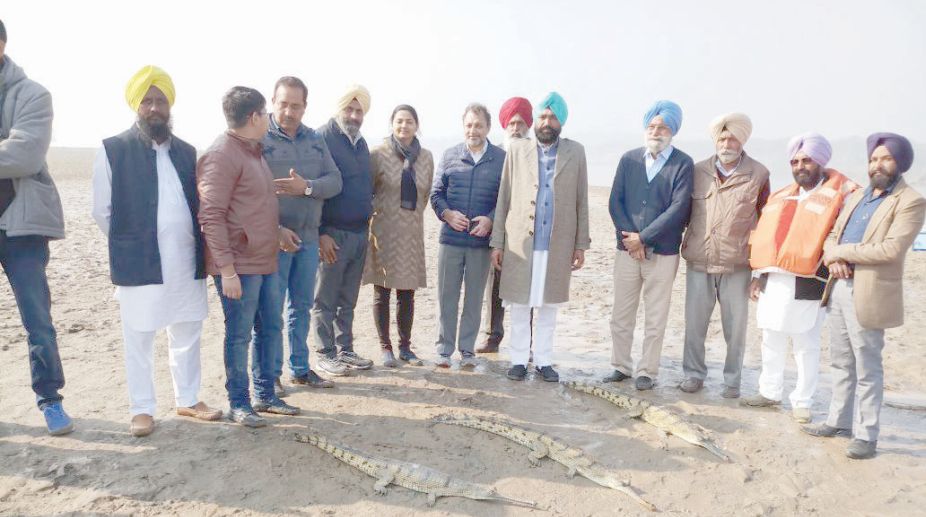Pre-monsoon survey launched in Satyamangalam Tiger Reserve
Around 300 personnel commenced the exercise in 10 ranges in the Sathyamangalam Division and in Hasanur Division that comes under the STR.

'Gharials' (Gavialis Gengeticus)
With the recent introduction of ten ‘Gharials’ (Gavialis Gengeticus), an Indian variety of crocodiles, at the Beas river near Gagrewal village, 30 km from Tarn Taran, Punjab’s decade-long wait has come to an end. The move is expected to boost eco-tourism alongside the Beas wetland area.
The step taken by the Punjab Forest and Wildlife Department has paved the way to bring more reptiles to the Harike wetland in coming days. The three-year-old, ten fish-eating reptiles were brought to the spot from Chhatbir Zoo in Mohali. However, farmers living adjoining the Harike wetland areaare apprehensive that the reptiles will prove dangerous for humans and damage crops. They did not allow the release of Gharials into the wetland.
Advertisement
The Harike site is the confluence of the Beas and Sutlej rivers. Residents of the area under the banner of Kisan Sangharsh Committee (KSC) have been opposing the move, terming it dangerous for people who frequently visit the area on boats to cultivate their land adjoining the wetland area. The forest officials are in the process of convincing the agitating farmers that Gharials are not dangerous and that the move will help clean the river water.
Advertisement
Farmers had recently sent a memorandum to Chief Minister Amarinder Singh on their opposition to the release of Gharials. “If the state government wants to release the reptiles in the wetland, it should purchase the farm land of the farmers falling near the river. We will not allow the government to release the animals in the river,” the memorandum had said.
Ferozepur range District Forest Officer (DFO) Charanjit Singh, told The Statesman that the reptiles were brought from Chhatbir Zoo to Gagrewal village. “They were released into the river as per the plan. The move is good to protect the ecology. We are likely to add a few more Gharials in coming days. Soon after resolving farmers’ concerns, we will release the Gharials in the Harike wetland as well,” he said.
Meanwhile, Assistant Professor at Department of Zoology and Environment Science at Punjabi University in Patiala, Dr Onkar Singh Brraich, said, “The move will not only conserve aquatic biodiversity of the Beas river, but the fishes so preserved will help in the survival of dolphins and Gharials. These endangered species are totally dependent on wild fishes. For the balance of ecology commercial fishing should be discouraged,” he said.
Brraich said there used to be a thick presence of dolphins and Gharials once upon a time in the Beas river. “The efforts to restore conservation are in the initial stage. It will need a lot of effort from the government to take control of the situation,” he said.
In July 2017, the CM with officials of the Wildlife Department gave in-principle approval to release Gharials into the Satluj and Beas rivers. Initially, 17 hatchlings of Gharials were planned to be released.
The proposal was initiated in 2005 for relocating around 100 Gharials in the wetlands. It took almost seven years to get the Central government’s nod. After this, the main hurdle was caused due to the people living near wetland areas who opposed the move. The breeding of Gharials had already started in the Chhatbir Zoo, and about 50 of them would be brought from Uttar Pradesh and Madhya Pradesh.
HARMLESS REPTILE
According to wildlife experts ‘Gharial’ is a harmless reptile as it does not attack humans or other mammals. The body structure of Gharial is designed to prey largely on fishes.
Gharials are physically different from ‘crocodiles’ as they have extremely long and thin jaws and they are predominantly fish eaters. On the other hand, crocodiles have broad snouts, enlarged scutes around the neck and they feed on fish, birds, reptiles and mammals. Of the total Gharial population of 5,000 in India, only 200 are at the breeding stage.
This freshwater reptile was once found in large numbers in the Indus river water system, but with the building of dams and barrages, it got confined to the wetlands. It vanished from Harike primarily due to unchecked hunting.
Advertisement